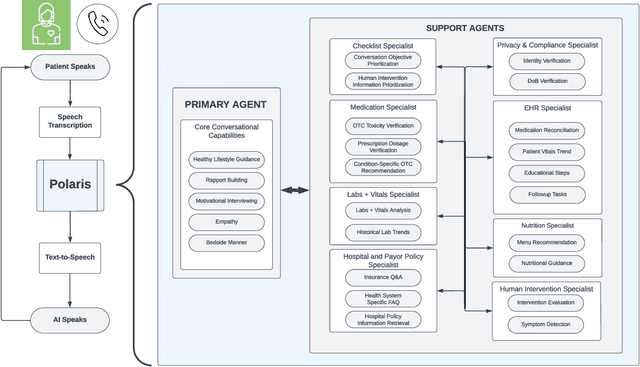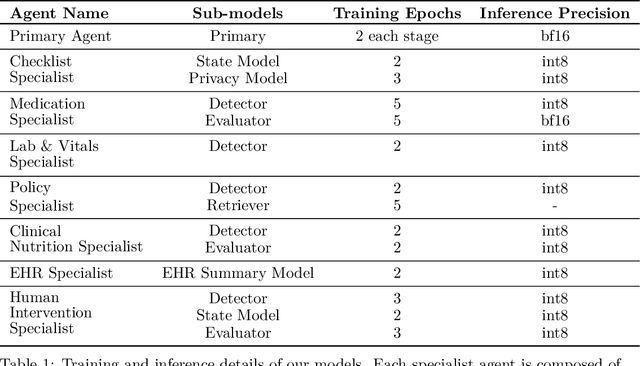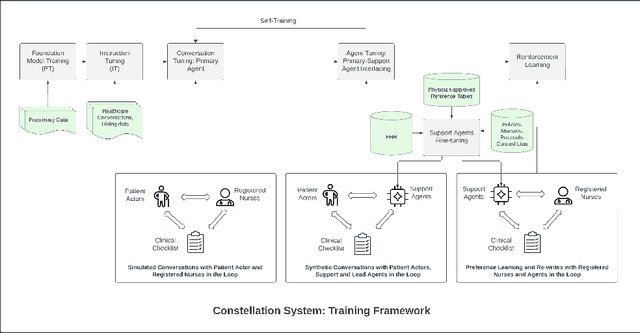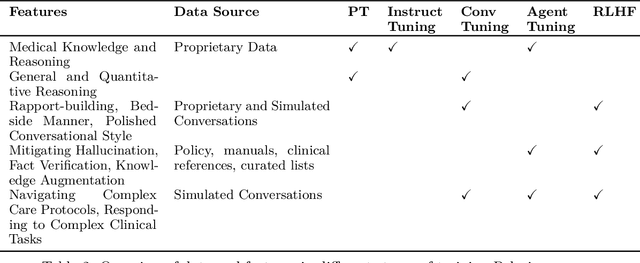Subhabrata Mukherjee
Retrieval-Augmented Generation with Graphs (GraphRAG)
Jan 08, 2025



Abstract:Retrieval-augmented generation (RAG) is a powerful technique that enhances downstream task execution by retrieving additional information, such as knowledge, skills, and tools from external sources. Graph, by its intrinsic "nodes connected by edges" nature, encodes massive heterogeneous and relational information, making it a golden resource for RAG in tremendous real-world applications. As a result, we have recently witnessed increasing attention on equipping RAG with Graph, i.e., GraphRAG. However, unlike conventional RAG, where the retriever, generator, and external data sources can be uniformly designed in the neural-embedding space, the uniqueness of graph-structured data, such as diverse-formatted and domain-specific relational knowledge, poses unique and significant challenges when designing GraphRAG for different domains. Given the broad applicability, the associated design challenges, and the recent surge in GraphRAG, a systematic and up-to-date survey of its key concepts and techniques is urgently desired. Following this motivation, we present a comprehensive and up-to-date survey on GraphRAG. Our survey first proposes a holistic GraphRAG framework by defining its key components, including query processor, retriever, organizer, generator, and data source. Furthermore, recognizing that graphs in different domains exhibit distinct relational patterns and require dedicated designs, we review GraphRAG techniques uniquely tailored to each domain. Finally, we discuss research challenges and brainstorm directions to inspire cross-disciplinary opportunities. Our survey repository is publicly maintained at https://github.com/Graph-RAG/GraphRAG/.
RED QUEEN: Safeguarding Large Language Models against Concealed Multi-Turn Jailbreaking
Sep 26, 2024



Abstract:The rapid progress of Large Language Models (LLMs) has opened up new opportunities across various domains and applications; yet it also presents challenges related to potential misuse. To mitigate such risks, red teaming has been employed as a proactive security measure to probe language models for harmful outputs via jailbreak attacks. However, current jailbreak attack approaches are single-turn with explicit malicious queries that do not fully capture the complexity of real-world interactions. In reality, users can engage in multi-turn interactions with LLM-based chat assistants, allowing them to conceal their true intentions in a more covert manner. To bridge this gap, we, first, propose a new jailbreak approach, RED QUEEN ATTACK. This method constructs a multi-turn scenario, concealing the malicious intent under the guise of preventing harm. We craft 40 scenarios that vary in turns and select 14 harmful categories to generate 56k multi-turn attack data points. We conduct comprehensive experiments on the RED QUEEN ATTACK with four representative LLM families of different sizes. Our experiments reveal that all LLMs are vulnerable to RED QUEEN ATTACK, reaching 87.62% attack success rate on GPT-4o and 75.4% on Llama3-70B. Further analysis reveals that larger models are more susceptible to the RED QUEEN ATTACK, with multi-turn structures and concealment strategies contributing to its success. To prioritize safety, we introduce a straightforward mitigation strategy called RED QUEEN GUARD, which aligns LLMs to effectively counter adversarial attacks. This approach reduces the attack success rate to below 1% while maintaining the model's performance across standard benchmarks. Full implementation and dataset are publicly accessible at https://github.com/kriti-hippo/red_queen.
Hybrid LLM: Cost-Efficient and Quality-Aware Query Routing
Apr 22, 2024Abstract:Large language models (LLMs) excel in most NLP tasks but also require expensive cloud servers for deployment due to their size, while smaller models that can be deployed on lower cost (e.g., edge) devices, tend to lag behind in terms of response quality. Therefore in this work we propose a hybrid inference approach which combines their respective strengths to save cost and maintain quality. Our approach uses a router that assigns queries to the small or large model based on the predicted query difficulty and the desired quality level. The desired quality level can be tuned dynamically at test time to seamlessly trade quality for cost as per the scenario requirements. In experiments our approach allows us to make up to 40% fewer calls to the large model, with no drop in response quality.
Polaris: A Safety-focused LLM Constellation Architecture for Healthcare
Mar 20, 2024



Abstract:We develop Polaris, the first safety-focused LLM constellation for real-time patient-AI healthcare conversations. Unlike prior LLM works in healthcare focusing on tasks like question answering, our work specifically focuses on long multi-turn voice conversations. Our one-trillion parameter constellation system is composed of several multibillion parameter LLMs as co-operative agents: a stateful primary agent that focuses on driving an engaging conversation and several specialist support agents focused on healthcare tasks performed by nurses to increase safety and reduce hallucinations. We develop a sophisticated training protocol for iterative co-training of the agents that optimize for diverse objectives. We train our models on proprietary data, clinical care plans, healthcare regulatory documents, medical manuals, and other medical reasoning documents. We align our models to speak like medical professionals, using organic healthcare conversations and simulated ones between patient actors and experienced nurses. This allows our system to express unique capabilities such as rapport building, trust building, empathy and bedside manner. Finally, we present the first comprehensive clinician evaluation of an LLM system for healthcare. We recruited over 1100 U.S. licensed nurses and over 130 U.S. licensed physicians to perform end-to-end conversational evaluations of our system by posing as patients and rating the system on several measures. We demonstrate Polaris performs on par with human nurses on aggregate across dimensions such as medical safety, clinical readiness, conversational quality, and bedside manner. Additionally, we conduct a challenging task-based evaluation of the individual specialist support agents, where we demonstrate our LLM agents significantly outperform a much larger general-purpose LLM (GPT-4) as well as from its own medium-size class (LLaMA-2 70B).
Teaching Language Models to Hallucinate Less with Synthetic Tasks
Oct 10, 2023



Abstract:Large language models (LLMs) frequently hallucinate on abstractive summarization tasks such as document-based question-answering, meeting summarization, and clinical report generation, even though all necessary information is included in context. However, optimizing LLMs to hallucinate less on these tasks is challenging, as hallucination is hard to efficiently evaluate at each optimization step. In this work, we show that reducing hallucination on a synthetic task can also reduce hallucination on real-world downstream tasks. Our method, SynTra, first designs a synthetic task where hallucinations are easy to elicit and measure. It next optimizes the LLM's system message via prefix-tuning on the synthetic task, and finally transfers the system message to realistic, hard-to-optimize tasks. Across three realistic abstractive summarization tasks, SynTra reduces hallucination for two 13B-parameter LLMs using only a synthetic retrieval task for supervision. We also find that optimizing the system message rather than the model weights can be critical; fine-tuning the entire model on the synthetic task can counterintuitively increase hallucination. Overall, SynTra demonstrates that the extra flexibility of working with synthetic data can help mitigate undesired behaviors in practice.
Task-Based MoE for Multitask Multilingual Machine Translation
Sep 11, 2023Abstract:Mixture-of-experts (MoE) architecture has been proven a powerful method for diverse tasks in training deep models in many applications. However, current MoE implementations are task agnostic, treating all tokens from different tasks in the same manner. In this work, we instead design a novel method that incorporates task information into MoE models at different granular levels with shared dynamic task-based adapters. Our experiments and analysis show the advantages of our approaches over the dense and canonical MoE models on multi-task multilingual machine translations. With task-specific adapters, our models can additionally generalize to new tasks efficiently.
SkipDecode: Autoregressive Skip Decoding with Batching and Caching for Efficient LLM Inference
Jul 05, 2023Abstract:Autoregressive large language models (LLMs) have made remarkable progress in various natural language generation tasks. However, they incur high computation cost and latency resulting from the autoregressive token-by-token generation. To address this issue, several approaches have been proposed to reduce computational cost using early-exit strategies. These strategies enable faster text generation using reduced computation without applying the full computation graph to each token. While existing token-level early exit methods show promising results for online inference, they cannot be readily applied for batch inferencing and Key-Value caching. This is because they have to wait until the last token in a batch exits before they can stop computing. This severely limits the practical application of such techniques. In this paper, we propose a simple and effective token-level early exit method, SkipDecode, designed to work seamlessly with batch inferencing and KV caching. It overcomes prior constraints by setting up a singular exit point for every token in a batch at each sequence position. It also guarantees a monotonic decrease in exit points, thereby eliminating the need to recompute KV Caches for preceding tokens. Rather than terminating computation prematurely as in prior works, our approach bypasses lower to middle layers, devoting most of the computational resources to upper layers, allowing later tokens to benefit from the compute expenditure by earlier tokens. Our experimental results show that SkipDecode can obtain 2x to 5x inference speedups with negligible regression across a variety of tasks. This is achieved using OPT models of 1.3 billion and 6.7 billion parameters, all the while being directly compatible with batching and KV caching optimization techniques.
Adversarial Robustness of Prompt-based Few-Shot Learning for Natural Language Understanding
Jun 21, 2023Abstract:State-of-the-art few-shot learning (FSL) methods leverage prompt-based fine-tuning to obtain remarkable results for natural language understanding (NLU) tasks. While much of the prior FSL methods focus on improving downstream task performance, there is a limited understanding of the adversarial robustness of such methods. In this work, we conduct an extensive study of several state-of-the-art FSL methods to assess their robustness to adversarial perturbations. To better understand the impact of various factors towards robustness (or the lack of it), we evaluate prompt-based FSL methods against fully fine-tuned models for aspects such as the use of unlabeled data, multiple prompts, number of few-shot examples, model size and type. Our results on six GLUE tasks indicate that compared to fully fine-tuned models, vanilla FSL methods lead to a notable relative drop in task performance (i.e., are less robust) in the face of adversarial perturbations. However, using (i) unlabeled data for prompt-based FSL and (ii) multiple prompts flip the trend. We further demonstrate that increasing the number of few-shot examples and model size lead to increased adversarial robustness of vanilla FSL methods. Broadly, our work sheds light on the adversarial robustness evaluation of prompt-based FSL methods for NLU tasks.
Orca: Progressive Learning from Complex Explanation Traces of GPT-4
Jun 05, 2023Abstract:Recent research has focused on enhancing the capability of smaller models through imitation learning, drawing on the outputs generated by large foundation models (LFMs). A number of issues impact the quality of these models, ranging from limited imitation signals from shallow LFM outputs; small scale homogeneous training data; and most notably a lack of rigorous evaluation resulting in overestimating the small model's capability as they tend to learn to imitate the style, but not the reasoning process of LFMs. To address these challenges, we develop Orca (We are working with our legal team to publicly release a diff of the model weights in accordance with LLaMA's release policy to be published at https://aka.ms/orca-lm), a 13-billion parameter model that learns to imitate the reasoning process of LFMs. Orca learns from rich signals from GPT-4 including explanation traces; step-by-step thought processes; and other complex instructions, guided by teacher assistance from ChatGPT. To promote this progressive learning, we tap into large-scale and diverse imitation data with judicious sampling and selection. Orca surpasses conventional state-of-the-art instruction-tuned models such as Vicuna-13B by more than 100% in complex zero-shot reasoning benchmarks like Big-Bench Hard (BBH) and 42% on AGIEval. Moreover, Orca reaches parity with ChatGPT on the BBH benchmark and shows competitive performance (4 pts gap with optimized system message) in professional and academic examinations like the SAT, LSAT, GRE, and GMAT, both in zero-shot settings without CoT; while trailing behind GPT-4. Our research indicates that learning from step-by-step explanations, whether these are generated by humans or more advanced AI models, is a promising direction to improve model capabilities and skills.
GRILL: Grounded Vision-language Pre-training via Aligning Text and Image Regions
May 24, 2023



Abstract:Generalization to unseen tasks is an important ability for few-shot learners to achieve better zero-/few-shot performance on diverse tasks. However, such generalization to vision-language tasks including grounding and generation tasks has been under-explored; existing few-shot VL models struggle to handle tasks that involve object grounding and multiple images such as visual commonsense reasoning or NLVR2. In this paper, we introduce GRILL, GRounded vIsion Language aLigning, a novel VL model that can be generalized to diverse tasks including visual question answering, captioning, and grounding tasks with no or very few training instances. Specifically, GRILL learns object grounding and localization by exploiting object-text alignments, which enables it to transfer to grounding tasks in a zero-/few-shot fashion. We evaluate our model on various zero-/few-shot VL tasks and show that it consistently surpasses the state-of-the-art few-shot methods.
 Add to Chrome
Add to Chrome Add to Firefox
Add to Firefox Add to Edge
Add to Edge